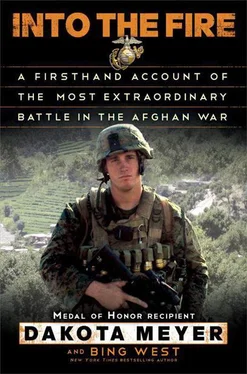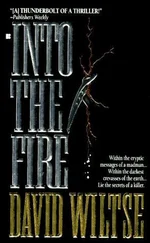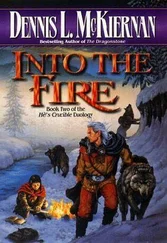In eastern Afghanistan in 2009, the U.S. Army provided the conventional battalions and the Marines supplied the advisors to the Afghan Army. Joyce was the headquarters for U.S. Army Battalion 1-32, tasked with preventing enemy infiltration from Pakistan. Joyce was also the headquarters for the Afghan battalion that we were advising.
While our four-man team was to live up at Monti, Lt. Johnson reported to Maj. Kevin Williams down at Joyce. Altogether, there were twenty-one Marines on the embedded training team, ETT 2-8. We were spread out in different numbers among five outposts like Monti. Each outpost was supposed to block the exit from a key valley. Insurgents avoided the posts by taking back trails around them. And since the tribesmen walked twice as fast as any American, you couldn’t sneak up on them out on those trails. The outposts, though, did cut down on the heavy supplies the bad guys moved from one point to another.
Before we left Joyce on the convoy to Monti, the local commander of the Afghan Army, Lt. Col. Eshok, greeted us warmly. He had fought against the Soviets and served as a bodyguard for Massoud, the famous warlord who was assassinated by Al Qaeda, two days before their attack on New York. Massoud was the man who was credited with defeating the Russians in Afghanistan. He opposed militant Islam as practiced by the Taliban and Al Qaeda, and organized the Northern Alliance against them. It was interesting to me that Massoud’s picture, and not President Hamid Karzai’s, hung on Eshok’s wall. Eshok had been on good terms with the advisor team we were replacing and had a standard speech.
“Kunar people like Americans,” he told each new team of advisors. “You bring money and build roads. We Askars [the Pashto word for soldiers] are your partners. The border police at this base are okay, but not the local police. They set up checkpoints to steal from the farmers.”
As we left Joyce, 1st Sgt. Christopher Garza, the top enlisted Marine on the ETT, said whatever supplies we four advisors needed would be on the next convoy north to Monti. However, the Afghan company we’d be working with would try to use us rather than their own supply line. Major Williams was all about pushing the Afghans to get their shit in order. So we shouldn’t do the Afghans’ work for them. Hold them accountable. That sounded like a good deal to me. Our headquarters down at Joyce would focus on straightening out the screwed-up Afghan logistics, leaving us four up at Monti a free hand to work on tactics and fighting.
We made our trip to Monti without incident.
Located on the remains of an old Afghan combat base, Combat Outpost Monti was typical of what you would see anywhere in Afghanistan: a flat rectangle of dust and gravel enclosed in Hescos and barbed wire. Hescos were square burlap bags as tall and wide as a man, held together by a wire frame and filled with a ton of dirt: inexpensive shields against bullets, RPG rounds, and truck bombers. At the gates and corners of Monti, two- and three-story concrete towers provided protection and some observation for the sentries.
The base was the size of six or seven football fields, one-quarter set aside for the Afghan soldiers and the rest for the Americans of Dog Company from Battalion 1-32. A hundred-man Afghan company lived in several plywood barracks to the south, separated by a line of Hescos and a parking lot from the barracks of one hundred U.S. soldiers. You have trucks and Humvees parked in rows, fuel and water bladders, a mess hall, showers, and plywood bunkhouses. Enough gravel is brought in so you are not always knee-deep in mud during the rainy season. Everything is prefab: the whole place is a beige and dusty Legoland. Lumber comes in quickly on trucks and copters and the defenses are put together before the enemy can decide what to do about it. Bigger bases are called forward operating bases, or FOBs, and they have compact hospitals and larger gyms. The combat outposts, or COPs, like Monti, were little forts on the frontier where you could be a little bit safer than if you were out in the open. The designation COP or FOB was flexible; a base might get bigger or smaller and still keep its original designation.
We four advisors moved into our own bunkhouse in the Afghan section, which you call a hooch—probably a word picked up by soldiers during the Vietnam war. Our little hooch had concrete walls inside. Ropes were nailed along the walls like towel racks to hang some of your stuff. There were little scraps of paper stapled to the wall—sports team posters, family photos, and calendars. There was flickering electric power from the generators, four beds made from wood, four folding canvas chairs, a plywood table, and four lumber T-stands to hold our body armor. There was an always-chattering tactical radio connected to Dog Company’s TOC (tactical operations center), located just across the other side of the Hesco barriers that divided the camp.
A Dog Company sergeant and the Marines we were replacing gave us the camp tour. The TOC was an impressive war room, with good views of everything around. There was a screen for watching live video feeds and replays from aircraft and drones circling the Pakistani border a few miles to the east. There were radio and satellite connections to higher headquarters and to the artillery guns just outside. There was a bank of radios for keeping in touch with patrols in the field, and detailed maps were taped on the walls. In a nearby room, they had a radio intercept unit listening to enemy chatter. Those on watch could steer long-range cameras on blimps floating thousands of feet in the sky and tethered at a base several miles to the south.
The problem with the area around Monti was that the terrain was too rough and steep for any kind of vehicle, once you got off the few roads that went along the rivers and not much more than a few hundred yards up the hollows. After that, it was all foot and hoof, which was why Monti was set up astride a main trail between Pakistan and Afghanistan. The mission was to cut down on enemy infiltration from Pakistan and to hold open a fifteen-mile section of road that ran alongside ridgelines so steep you could roll rocks down on passing vehicles.
The soldiers from Dog Company explained that the enemy was a collection of insurgent groups with different names, grievances, and ambitions. They were Taliban with a small “t.” Some were allied with Al Qaeda terrorists; others were warlords and smugglers. Some were die-hard Islamist mujahideen or holy warriors, dedicated to killing infidels; others were illiterate teenagers drawn by adventure and male bonding. In a kahol , or extended family, if one son joined the Taliban, the chances were that others would follow to fight in the same gang. If the leader was killed, someone from inside the gang, usually a relative, replaced him.
They warned us never to let down our guard. We lived in the shadow of Pakistan, a vast, 1,500-mile-long sanctuary with disciplined guerrilla fighters. We listened to radio intercepts of insurgents taunting us from Pakistani towns ten miles away. We watched video from UAVs (unmanned aerial vehicles) that showed Pakistani trucks driving up to the border and loading munitions onto donkey trains. In the towns, money-changers sat at glass tables, offering Pakistani rupees for the Afghan soldiers’ paychecks. Most of the finished goods in the area—clothes, shovels, pots, bicycles—were manufactured in Pakistan. Families, merchants, smugglers, traders, and insurgents walked daily across the border. To the Pashtuns, Pakistan wasn’t a country; it was the far side of the mountain where their cousins lived.
“We’ll keep the four of you posted if anything big is going on in the sector,” said the sergeant who gave us the tour. “There’s a radio in your hooch. You let us know whenever you leave the wire on patrol.”
Читать дальше












